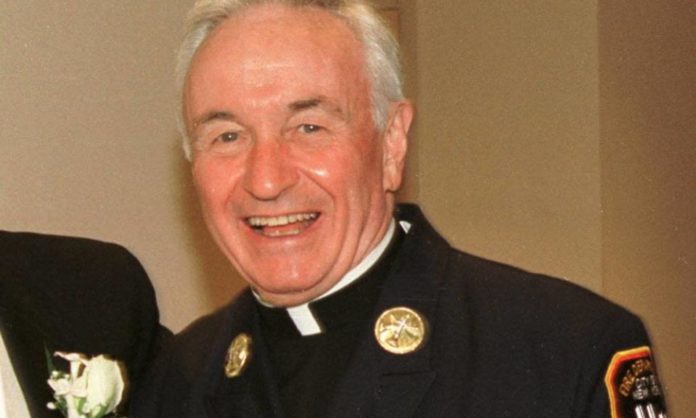
Admirers of father Mychal Judge, the New York City Fire Department (FDNY) chaplain who died on 9/11, have asked for the priest to be considered for sainthood.
Judge is remembered as a hero of the attacks on the World Trade Center on 11 September, 2001.
He arrived at the World Trade Center shortly after the first plane hit that morning, NPR reported.
The chaplain went with firefighters and other first responders into the North Tower to find and rescue survivors of the horrific attack. As he prayed in the North Tower’s lobby for the rescuers, the victims and the dead, he was killed by debris from the falling South Tower, making him the first recorded victim of 9/11.
On the 20th anniversary of 9/11, some of Judge’s many admirers have called for him to be granted sainthood.
Jesuit priest James Martin, who is a staunch LGBT+ advocate in the Church, told the Associated Press that Mychal Judge showed “that you can be gay and holy”.
According to outlet, he was a gay man who devoted himself to serving the vulnerable populations of New York City. He worked to help the homeless and founded one of the first Catholic HIV and AIDS ministries in New York City at the peak of the AIDS crisis in the 80s.
“Father Judge’s selflessness is a reminder of the sanctity that the church often overlooks in LGBTQ people,” Martin said. “Heaven is filled with LGBTQ people. All the church has to do is start to recognise this.”
The process to make someone a saint – also known as canonisation – is lengthy and complex. It can take several years or even decades from start to finish. However, in 2017, Pope Francis added a new pathway to possible sainthood for people who sacrificed their lives for others.
According to NPR, this new category includes criteria for if the individual freely and voluntarily offered their lives in the face of a “certain and soon-to-come-death”. The person needed to embody Christian virtues before and after their death, and they must have performed a miracle.
Reverend Luis Escalante, who has investigated possible sainthood cases for the Vatican, told AP that he received several testimonies supporting Mychal Judge’s canonisation after this 2017 announcement. Escalante said several accounts described the 9/11 hero as “the best icon” of humanity.
Francis DeBernardo, leader of the LGBT+ Catholic advocacy group New Ways Ministry, told the AP he was among those who provided testimonies to Escalante about Judge’s life and work.
He added he would be forming a group to promote Mychal Judge’s sainthood with the help of firefighters, LGBT+ people and other communities Judge worked with.
“It would be a testimony to Fr Judge’s legacy if these diverse sectors of society came together to work for the canonisation of a man they already know is a saint,” DeBernardo said in an email to the AP.


How do you become a saint?
Being named a saint is seen as a great religious honour given to people after they’ve died. Traditionally, canonisation cannot normally start until at least five years after they’ve died.
After this time is up, the bishop, usually of the deceased’s diocese, will look for evidence of a devout and virtuous life. Religious groups can also ask the bishop to open an investigation.
The evidence is submitted to the Congregation for the Causes of Saints – a panel that advises the Pope on saints – for further investigation. On their approval, the Pope can then decide if the person was of “heroic virtue”. If this is the case, the person is declared “venerable”, which is a step closer to sainthood.
The next stage involves proof of miracles. A miracle must be attributed to prayers made to the individual after their death. This needs to be verified by the Vatican with evidence before it is accepted as a miracle.
Once it is confirmed as a miracle, the candidate is beatified and given the title “blessed”.
But, if the candidate is considered a martyr because they died for their faith, they do not need to be associated with miracles.
The canonisation is the final step before a candidate is declared a saint. This usually involves a second miracle being attributed to the individual. One this is confirmed by the Vatican, the person is canonised through a formal papal decree. The Pope makes the declaration through a special mass in honour of the new saint.
These masses can attract huge audiences. Hundreds of thousands of people gathered in Rome to witness the double canonisation of Popes John Paul II and John XXIII in 2014, according to The Guardian.








